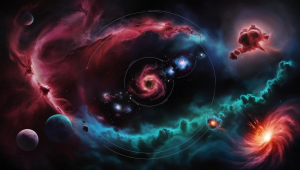
WORMHOLES:COSMIC SHORTCUTS
What if you could rocket from Earth, not to the Moon or Mars, but down a wormhole that loops all the way across the vast Milky Way, slashing travel time
In the detailed tapestry of our cosmos there exist worlds that thwart our straight understanding, concealing their keys within the material of room together with time. To discover these challenges mankind has actually established advanced devices, among one of the most exceptional being the particle collider. These enormous equipment spread throughout the world drive fragments to amazing rates, collapsing them with each other to disclose the essential foundation of presence coupled with the regulations that regulate them.
At the heart of particle colliders exists a mission for expertise, a bottomless interest to recognize deep space’s internal processes. Their building and construction along with procedure stand for a pinnacle of human resourcefulness combining progressed design, academic physics, and also computer expertise. With these ventures researchers discover the basic pressures of nature probe the beginnings of issue together with also look right into the midst of deep space.
Among one of the most popular instances of these marvels of scientific research is the Large Hadron Collider (LHC) situated at CERN, the European Organization for Nuclear Research spanning the Franco-Swiss boundary near Geneva. With its 27-kilometer ring hidden below the Earth’s surface area the LHC stands as the biggest along with the most effective particle collider ever before constructed. Within its confusing passages, protons are sped up to almost the rate of light prior to being hit head-on producing problems evocative of the onset of the world portions of a 2nd after deep space.
The main goal of the LHC is to clarify the evasive Higgs boson, a bit hypothesized to present various other bits with mass. In 2012, after years of academic expectancy plus speculative search, researchers at CERN introduced the exploration of the Higgs boson, confirming the Standard Model of bit physics as well as making François Englert as well as Peter Higgs the Nobel Prize in Physics. This significant success highlighted the transformative power of particle colliders in deciphering deep space’s secrets.
Past the search of the Higgs boson, particle colliders look into worlds much past the range of day-to-day experience. They discover the essential pressures that regulate deep space: electromagnetism, gravity, the solid nuclear pressure, as well as the weak nuclear pressure. By subjecting bits to severe problems scientists recreate the high-energy settings common throughout the cosmos’s early stage permitting them to research sensations hard to reach via traditional ways.
Particle colliders additionally play an essential function in attending to several of one of the most extensive inquiries in cosmology as well as astrophysics. They clarified the nature of dark matter, an unseen compound that makes up most of deep space’s mass yet continues to be undetected via straight monitoring. Via indirect techniques such as taking a look at the particles generated in bit accidents researchers wish to figure out the enigma of dark issue as well as its impact on deep space.
In addition, these exceptional equipment supply understanding right into the principle of antimatter, the mirror picture of regular issues with contrary electrical fee. While antimatter continues to be limited in the observable world, particle colliders produce it in wealth enabling researchers to research its residential or commercial properties plus habits under regulated problems. Comprehending antimatter might open brand-new boundaries in power manufacturing, room expedition, along with also the look for extraterrestrial life.
In addition, particle colliders function as crucibles for development driving technical improvements with extensive effects. The cutting edge detectors released in these experiments use modern products, electronic devices along with mathematical formulas to document together with evaluate bit communications with exceptional accuracy. Such advancements not just grow our understanding of essential physics yet additionally locate applications in varied areas from clinical imaging to products of scientific research.

Regardless of their enormous success, particle colliders challenge enormous difficulties as well as debates. Their building requires huge monetary financial investments together with global partnership on an unmatched range. Doubters elevate issues concerning the honest ramifications of probing the unidentified, being afraid of unanticipated effects or abuse of clinical understanding. Furthermore some inquiry the prioritization of fundamental study over much more prompt public demands highlighting the fragile equilibrium in between clinical expedition as well as public top priorities.
However, the tradition of particle colliders goes beyond clinical questions incorporating mankind’s ruthless quest of understanding as well as understanding. They stand as monoliths to human inquisitiveness as well as ingenuity, brightening the planetary tapestry that borders us and also motivating future generations to venture right into the unidentified. As we remain to probe the midsts of deep space, particle colliders continue to be signs of exploration, assisting us towards a much deeper understanding of our location in deep space.

What if you could rocket from Earth, not to the Moon or Mars, but down a wormhole that loops all the way across the vast Milky Way, slashing travel time

If you go outdoors on a clear evening and also search for it, you might have the ability to see Jupiter beaming brilliantly amongst the celebrities. At the exact same

Stars, the dazzling points of light that fill up the evening skies are the foundation of galaxies plus the cradles of life itself. From their birth in large clouds of

In the mission to recognize deep space mankind has actually developed progressively effective devices to observe deep space. Completion of this venture is the Extremely Large Telescope (ELT) which is

Space debris, also known as space junk, refers to the defunct artificial objects orbiting Earth. These objects include decommissioned satellites, spent rocket stages, and fragments from collisions and explosions.

The search for exoplanets– planets that orbit stars outside our planetary system– has actually quickly developed into one of the most interesting and dynamic fields of astronomy
Write to
Jasmine Gogoi at csr@scientifictemperament.com
Let’s develop our society with a scientific heart. Join us to build the scientifically nurtured future →